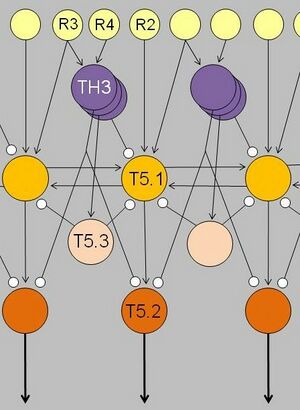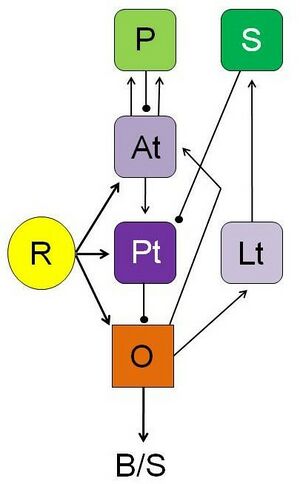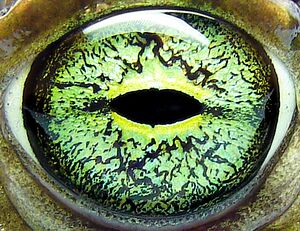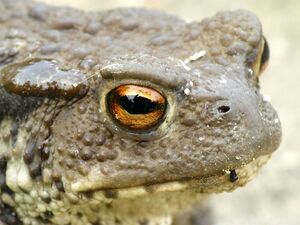الرؤية لدى العلاجيم
The neural basis of prey detection, recognition, and orientation was studied in depth by Jörg-Peter Ewert in a series of experiments that made the toad visual system a model system in neuroethology (neural basis of natural behavior). He began by observing the natural prey catching behavior of the common European toad (Bufo bufo).
Ewert's work with toads yielded several important discoveries (Ewert 1974, 2004). In general, his research revealed the specific neural circuits for recognition of complex visual stimuli. Specifically, he identified two main regions of the brain, the tectum and the thalamic-pretectal region, that were responsible for discriminating prey from non-prey and revealed the neural pathways that connected them. Furthermore, he found that the neural mechanisms are plastic and adaptable to varying environments and conditions (Carew 2000; Zupanc 2004).
. . . . . . . . . . . . . . . . . . . . . . . . . . . . . . . . . . . . . . . . . . . . . . . . . . . . . . . . . . . . . . . . . . . . . . . . . . . . . . . . . . . . . . . . . . . . . . . . . . . . . . . . . . . . . . . . . . . . . . . . . . . . . . . . . . . . . . . . . . . . . . . . . . . . . . . . . . . . . . . . . . . . . . . .
Natural toad behavior
Prey vs. predator response
Feature detectors and the visual system


Modulatory loops and evolutionary perspectives
Stereopsis in Toads
See also
References
- Carew, T.J (2000). Feature analysis in Toads. In Behavioral Neurobiology, Sunderland, MA: Sinauer, 95-119.
- Ewert, J.-P. (1974). The neural basis of visually guided behavior. Scientific American, 230(3), 34-42.
- Ewert, J.-P. (1980). Neuroethology: an introduction to the neurophysiological fundamentals of behavior. Springer-Verlag, Berlin/Heidelberg/New York.
- Ewert J.-P. (2004) Motion perception shapes the visual world of amphibians. In: Prete F.R. (Ed.) Complex Worlds from Simpler Nervous Systems. Cambridge, MA, MIT Press, pp. 117–160
- Ewert J.-P., Schwippert W.W. (2006) Modulation of visual perception and action by forebrain structures and their interactions in amphibians. In: Levin E.D. (ed.) Neurotransmitter Interactions and Cognitive Function. Birkhäuser, Basel, pp. 99–136
- González A., Smeets W.J., Marín O. (1999). Evidences for shared features in the organization of the basal ganglia in tetrapods: studies in amphibians. Eur. J. Morphol., 37(2-3), 151-154.
- Kenigfest N.B., Belekhova M.G., Karamyan O.A., Minakova M.N., Rio J.-P., Reperant J. (2002). Neurochemical organization of the turtle protectum: an immunohistochemical study. Comparative analysis. J. Evol. Biochem. Physiol., 38(6), 673-688.
- Nityananda, V., and J. C. A. Read. 2017. Stereopsis in animals: evolution, function and mechanisms. Journal of Experimental Biology 220:2502–2512.
- Reiner A., Medina L., Veenman C.L. (1998). Structural and functional evolution of the basal ganglia in vertebrates. Brain. Res. Rev., 28, 235-285.
- Zupanc, G. (2004) Behavioral Neurobiology: An Integrative Approach. Oxford University Press. 121-132.



